Civil defence in Ireland 1939–45
Published in 20th-century / Contemporary History, Features, Issue 2 (March/April 2018), Volume 26Cork city—a case-study.
By Pat Poland
In the early hours of Saturday 31 May 1941, the Whit bank holiday weekend, Acting Chief Officer John J. McInerney of Cork Fire Brigade was summoned from his quarters at the Central Fire Station to the watchroom to take an urgent telephone call. Bombs had again fallen on Dublin, he was told, but this was far more serious than anything hitherto experienced. There were many deaths and serious injuries, and no one knew whether this was just the beginning of a series of attacks on Éire. Cork might very well be next. McInerney at once drove to the home of the city manager, Philip Monahan, where he met the heads of other air raid precautions (ARP) services. All agreed on one thing: the equipping of ARP depots and auxiliary fire service (AFS) stations must proceed without delay. Early in 1941, in the aftermath of bombs falling on Dublin and other places, suitable premises had been identified, but now, four months later, rescue equipment and seventeen AFS pumps remained corralled at the big ARP stores on MacCurtain Street. Volunteers from the various services were quickly mobilised and the equipping of the depots began.
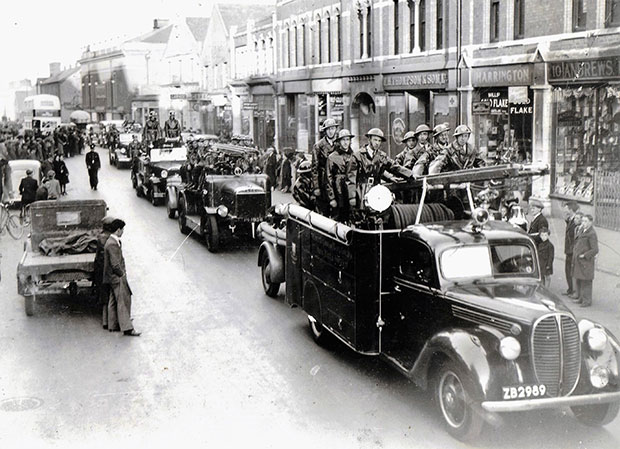
Above: Auxiliary fire service (AFS) appliances in an ARP parade through Cork city, May 1941. (Cork Examiner)
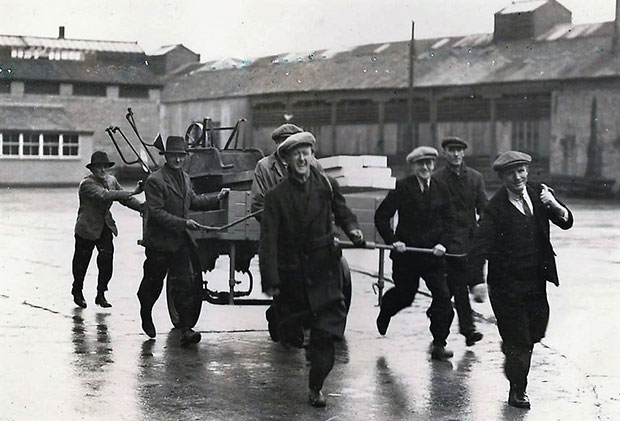
Above: A unit of the rescue service. As a result of petrol rationing the availability of motor transport was greatly reduced. Members were not issued with uniform, only helmet and overalls, considered by the army chief-of-staff to be a factor in the poor numbers volunteering for the service. (Cork Examiner)
Following the publication of the report of the tribunal of inquiry into the tragedy at Pearse Street, Dublin, in 1936, during which three firefighters lost their lives, in November 1937 Lt. Col. Guy Symonds CBE DSO, fire adviser to the British Home Office, was invited to survey the fire services in Dublin and its hinterland. On receipt of his audit, the Dublin Fire Brigade was reorganised under a new chief superintendent, Major J.J. Comerford ME, Director of Military Engineering. Comerford was sent to England to study ARP and emergency fire-fighting methods, while Symonds was invited back to Dublin to advise the government on civil defence measures.
Air Raid Precautions Act 1939
Pre-war civil defence planning in Ireland was predicated on the assumption that air raids on our territory emanating from Germany constituted only the remotest possibility. Germany was, after all, over 800 miles away. The logic was that aircraft, flying from airfields there, would have to take the shortest route across the North Sea to launch an attack. To raid Belfast, for example, strategists reasoned that bombers would have to fly across the width of England, encountering its formidable phalanxes of anti-aircraft guns, searchlights, barrage balloons and fighter aircraft, to reach Ireland. In a 1938 article entitled ‘The vulnerability of Ireland in war’, Irish Army officer Col. J.J. O’Connell questioned the received wisdom, but nobody paid much attention. By the summer of 1940, however, the march of events had redrawn the map of Europe, with Luftwaffe bases stretching from northern France to the Arctic Circle. Ireland now lay well within striking distance of the great Kampfgruppen of bombers stationed in Brittany, sending the ARP planners hurrying back to their drawing-boards.
On 26 July 1939 the Air Raid Precautions (ARP) Act 1939 became law. Local authorities were charged with giving effect to approved ARP plans and received from the state technical advice, special equipment and financial assistance of 75% of the cost of schemes. In Cork city, the ultimate responsibility for implementing the ARP scheme rested with Philip Monahan, as chief executive of the county borough. An ARP branch of the Department of Defence (later called the Military Directorate of Civil Defence), headed by Col. Seán O’Sullivan, was instituted, whose brief was to draw up plans relating to establishments, equipment schedules, evacuation arrangements, training schemes and advisory services, and to oversee their implementation.
ARP in Cork
On 8 October 1940 the Cork Corporation ARP subcommittee laid its plans before council. They had satisfied themselves, they said, that the ARP Act required them to prepare such a scheme and, if they failed to do so, the minister had the power to dissolve the corporation. They recommended that for operational purposes the city be divided into four areas—north-west, north-east, south-west and south-east. Air raid shelters to serve the crowded business centres, and districts where the houses were so structurally decayed as to be likely to collapse in the event of the bursting of high explosives in the vicinity, would have to be built. First-aid posts, AFS stations, a decontamination centre, air raid warning sirens, message centres and a control centre would all be required. An appeal would go out for 600 air raid wardens, 500 first-aid workers and 200 volunteer firefighters (subsequently revised upwards to 389 by the Department of Defence).
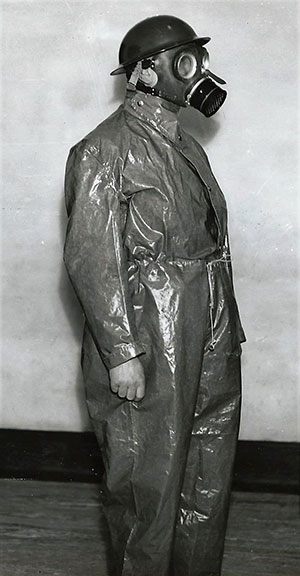
Above: What the well-dressed man was wearing in 1941. A member of the decontamination service ready for action. (Cork Examiner)
The infrastructure, matériel and services provided under the general heading of ARP in Cork city may be summarised as follows.
- Air raid shelters. One hundred street shelters were built and all were in place by November 1941. Each had a 50-person capacity and were designed to withstand the blast from a 500kg high-explosive bomb at 50ft. Despite reservations about their efficacy, Major Comerford, after consulting with the chief engineer in London, considered that the ‘street shelters provided in Éire were very much ahead of the standard shelter in Britain’. Plans for three large city-centre underground shelters, each capable of holding 500 people, never materialised owing to cost.
- Air raid warning sirens. In January 1941 ten sirens were erected at key points around the city, electronically operated from the ARP control centre in the (specially strengthened) basement of the Washington Street courthouse. They were tested monthly, the public being notified in advance by way of press announcements.
- Emergency static water tanks. Major Comerford considered that, even after a ‘sporadic raid’, at least 10,000 gallons of water a minute would be required for firefighting. The authorities had calculated that Cork required some twenty emergency water tanks, each of 9,000 gallons capacity. By the end of the war just twelve had been provided. When a little girl almost drowned in one of them in April 1943 a citywide inspection was ordered. The city ARP officer found that ‘large quantities of stones and rubbish had been dumped in some of them, and in others there is practically no water, and the little there is, is filthy and green with slime’. An inspection regime was put in place under the general supervision of the fire service.
- Provision of respirators (‘gas masks’). Civilian respirators were delivered unassembled and an appeal went out for volunteers to help in putting them together. The response was overwhelming, and 85,000 respirators were completed at Cork’s Eglinton Street swimming baths in July 1941 and distributed to the public at national schools. Shortly after, the baths were closed—ostensibly to save fuel—and filled with cheap coffins, where they remained until late 1944 when the danger of air raids had passed.
- ARP services. Services included AFS, wardens, rescue and demolition, decontamination and casualty, the latter provided by existing formations such as the St John Ambulance Brigade and the Irish Red Cross Society. Additionally, any area of the state under attack could call on the services of the Civil Defence Firefighting Company. Based at the Curragh Camp, Co. Kildare, this was a special unit formed from the Army Corps of Engineers and comprised a mobile column of six Fordson fire engines towing large trailer pumps.
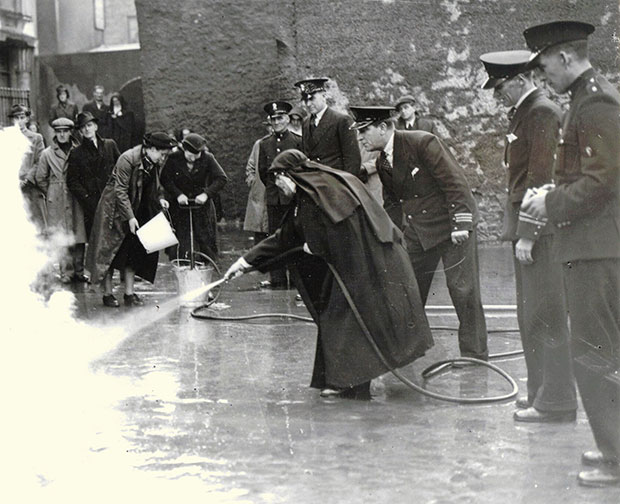
Above: Schoolteachers (including a nun) are shown how to extinguish an incendiary bomb by Fire Brigade members, 1941. (Cork Examiner)
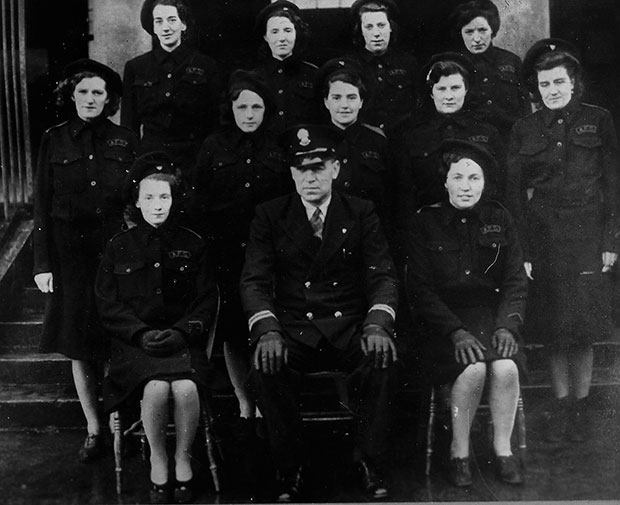
Above: Turner’s Cross women’s section of the Cork AFS with their instructor, Station Officer John F. Crowley, in 1943. Members were trained to operate message and control centres. (Cork Examiner)
The greatest threat to ARP, however, proved not to be the hypothetical bombs that never materialised but public apathy. After an initial surge of interest in 1941, the numbers steadily declined across all services. By November 1942 the effective strength of the AFS was 148—38% of the established strength. The rescue and demolition service fared even worse. With an established strength of 312, its effective strength was just 90. Regular appeals in the press for more volunteers did little to alleviate the situation. (Nor was ARP the only service to be thus afflicted. In March 1944, the army chief-of-staff reported to Minister for Defence Oscar Traynor that ‘about one-third of the Local Defence Force has ceased to exist’.)
Threats to Cork?
How serious was the threat of an air raid on Cork, and how effective would the civil defence services have been? There is no doubt that from mid- to late 1940 the Irish government considered invasion a real possibility. Following the defeat of the Luftwaffe by the RAF in the Battle of Britain in the late summer of that year, there was the threat that Hitler would invoke the Wehrmacht’s Fall Gruen (Case Green): the plan for the invasion of southern Ireland by landing five to six divisions, comprising parachutists and seaborne troops, on a front between Waterford and Cork. Indeed, at one high-level military conference Hitler mused that the ‘occupation of Ireland might lead to the end of the war’. Ireland would provide ideal bases for U-boat ‘wolf packs’ to prosecute the war in the Atlantic and to launch concerted air attacks on Britain. And a principal objective of any would-be invader would be the capture of Cork, headquarters of the army’s southern command and Maj. Gen. Costello’s 1st Division. Collins Barracks, spread over some 48 acres of dense building, high up and exposed, would be a principal military target in any attack from the air. With the fall of France, Cork lay well within the range of German bombers stationed in the north-west of that country. The city is situated at the head of a great harbour and water cannot be blacked out. If an attack took place on a bright, moonlit night (preferable) despite the partial blackout (pre-midnight) and total blackout (post-midnight) the city would be easily identified. Aircraft would be guided by prominent landmarks along the coast, aided by a veritable ‘flight path’ of lighthouse beacons from Hook Head to Roche’s Point, all of which continued to function throughout the Emergency.
Any attacking force, in the absence of radar and an early-warning system, could have approached Cork city practically unannounced and unopposed. There were no fighter aircraft to scramble, no balloon barrage and no anti-aircraft guns. The sole anti-aircraft gun, a Bofors L/60 40mm piece (not installed until 1942), along with searchlights on the harbour forts, was located on Spike Island. Reports of aircraft passing into Éire’s airspace depended on observers of the coast-watching service in lookout posts (LOPs) relaying telephone messages, tortuously, up the chain of command. Even if the Cork authorities received a warning of aircraft heading for the city, it is doubtful whether the sirens would have been activated. Dublin, which was bombed on several occasions, was loath to sound the sirens so as not to ‘unnecessarily alarm the populace’. The conclusion must be that raiders would arrive over Cork—a city unprepared and unprotected—without any warning being given. In any event, at a time when most people did not have telephones in their homes, how were the ARP volunteers to be alerted? If no sirens were sounded, presumably the first intimation they would have that they were required would be when bombs started to fall.
Air raid shelters were too few. Fully occupied, they would have accommodated just 5,000 people—about 6% of the population of the city. In any case, they were not constructed to provide protection against heavy bombs. Domestic ‘Anderson’ shelters were not supplied to the public as was the case in the UK, and the government’s offer to subsidise private ‘beehive’ shelters appears not to have enjoyed widespread take-up. The fire service—both regular and AFS—was under-equipped and under-staffed to deal with an air raid. The regular brigade could field, at best, four crews. From the experience of bombed cities, we know that telecommunications and vital public utilities, such as water mains, were put out of action early on. As noted, when a citywide inspection of emergency water tanks was carried out, many were found to be full of rubbish and stagnant water. A chronic shortage of transport, especially after petrol rationing was introduced, added to the many difficulties of the ARP services. During exercises most fire pumps had to be manhandled to incidents. Given Cork’s hilly terrain, this was a challenging situation for the crews, particularly for those having to pull the bigger pumps.
The reasons for this lamentable state of unreadiness are not, of course, mono-causal but varied and complex, although funding must rate very highly. Éire was neutral, and this was a significant factor in the official attitude towards civil defence; the prospect of bombing seemed so remote as not to warrant serious consideration. One military historian summarised the position thus:
‘There must be grave doubt as to the adequacy of the resources available to ARP and the effectiveness of the organization, training and equipment. In 1943, the military directorate [of civil defence] carried out a full assessment of Belfast ARP Services … and concluded that part-time, volunteer personnel were of little value. Belfast had found it necessary to recruit and train large numbers of full-time personnel. Expenditure in Belfast in 1942 alone was estimated at £2 million. Resources on this scale were never allocated to civil defence here.’
The conclusion must be drawn that had Cork suffered even a sporadic air attack we would now be recalling an unspeakable tragedy.
Pat Poland is retired from the Fire Service.
FURTHER READING
Air Raid Precautions Memorandum No. 22: The Auxiliary Fire Service (Dublin, 1943).
Kennedy & V. Laing, The Irish Defence Forces 1940–1949: the Chief of Staff’s Reports (Dublin, 2011).
Col. J.J. O’Connell, ‘The vulnerability of Ireland in war’, Studies 27 (Dublin, 1938).
The call to arms: a historical record of Ireland’s defence services (Dublin, 1945).


















